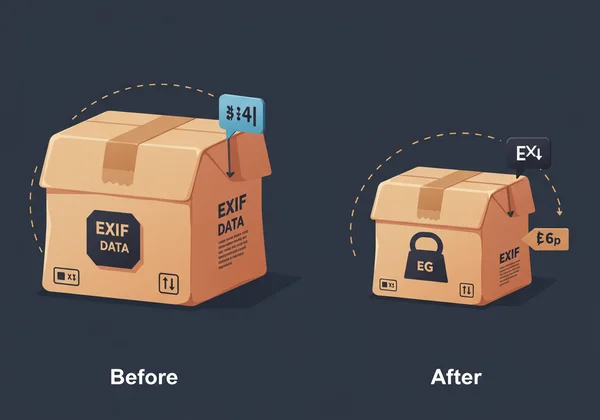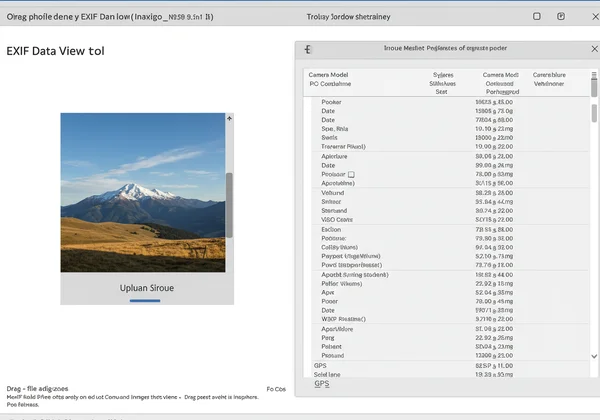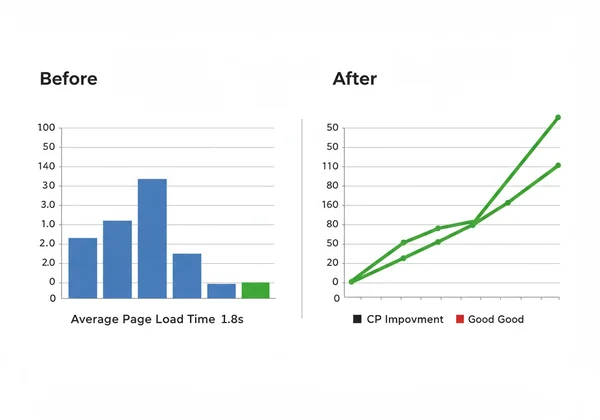Strip EXIF Data for SEO: Boost Page Speed & Core Web Vitals
In today's hyper-competitive digital landscape, speed isn't merely a feature—it's the very foundation of an exceptional user experience and a critical SEO ranking factor. For website owners, marketers, and content creators, slow-loading images are a silent killer of performance. But what if a significant portion of that slowdown is caused by hidden, invisible data you didn't even know existed? It's time to ask: what is exif data and how can you strip exif data to unlock a faster, higher-ranking website?

This guide will demystify EXIF data, revealing how this metadata bloats your image files and harms your site's performance. More importantly, we'll walk you through how to identify and manage this data, transforming your image optimization strategy and significantly improving your Core Web Vitals. Before you upload another image, check your photo details with a secure tool to see what's hiding inside.
Understanding EXIF Data & Its Impact on Page Speed
At its core, image optimization is about reducing file size without sacrificing visual quality. While most people focus on compression and dimensions, they often overlook the impact of metadata. This hidden information, while useful for photographers, can be dead weight on a website, directly impacting how quickly your pages load for visitors and search engine crawlers.
What is EXIF Data and Why Does it Matter for Websites?
EXIF (Exchangeable Image File Format) is a standard that specifies the formats for images, sound, and ancillary tags used by digital cameras, smartphones, and scanners. This data is embedded directly into the image file itself. It includes a wealth of information, such as:
- Camera Settings: Make, model, aperture, shutter speed, ISO speed.
- Date and Time: When the photo was taken.
- GPS Coordinates: The precise location where the image was captured.
- Copyright Information: Details about the author and rights.
- Thumbnail: A small preview of the image.
For a website, most of this data is completely unnecessary. Visitors don't need to know the ISO setting of a product photo, and search engines don't use it for ranking. However, this metadata still has to be downloaded by the user's browser, contributing to slower load times and a poorer user experience.
The Hidden Cost: How Metadata Increases Image File Size
While a few kilobytes of EXIF data on a single image might seem insignificant, it adds up quickly. A website with hundreds or thousands of images is carrying a substantial amount of unnecessary data. This "metadata bloat" can increase an image's file size by 5-15% or even more, depending on the camera and settings.
Think of it like this: every image you upload is a package being sent to your user. The visual part of the image is the content of the package. The EXIF data is extra, heavy packing material. By stripping this data, you're removing the unnecessary weight, allowing the package to be delivered faster. This directly translates to improved website performance and happier visitors, who are more likely to stay, engage, and convert. You can easily see how much data is attached to your pictures with a powerful online exif viewer.

Stripping EXIF Data: Your Key to Faster Load Times
Removing non-essential metadata is one of the most effective yet overlooked strategies for image optimization. It’s a simple action with a direct, positive impact on key performance metrics that Google uses to evaluate and rank your website. By cleaning your images before you upload them, you are taking a proactive step to improve page speed.
How Removing Metadata Boosts Core Web Vitals
Google's Core Web Vitals are a set of specific factors that are considered important for a website's overall user experience. The most relevant metric here is the Largest Contentful Paint (LCP), which measures the time it takes for the largest image or text block on the page to become visible.
Smaller image files load faster. It's a simple equation. By stripping EXIF data, you reduce the overall file size of your images. This allows the browser to download and render them more quickly, leading to a significantly improved LCP score. A better LCP tells Google that your page provides a fast, efficient experience, which can contribute to higher search engine rankings.
Step-by-Step: Checking EXIF Data with Our Online Tool
Before you can remove metadata, you need to see what's there. Using a dedicated tool is the essential first step in your optimization workflow. Our secure online tool provides a powerful way to do this, with a crucial advantage: privacy.
Unlike other tools that require you to upload your files, our platform processes everything directly in your browser. Your images never leave your computer, ensuring complete confidentiality and security—perfect for sensitive client photos or proprietary product images.

Here's how to check your images:
- Visit the Homepage: Navigate to our free tool to get started.
- Select Your Image: Drag and drop your image file directly onto the page, or click the button to select a file from your computer. You can even analyze an image by pasting its URL.
- Analyze the Data Instantly: The tool will immediately parse the image and display all embedded metadata in a clean, organized format. You'll see everything from basic camera info to detailed GPS coordinates.
- Audit for Optimization: Review the data to see how much non-essential information is present. This audit confirms which images need to be stripped of their metadata before being uploaded to your website.
This simple audit process empowers you to make informed decisions about your image optimization strategy.
Real-World Impact: An SEO Page Speed Case Study
While theory offers insight, it's the tangible results that truly speak volumes. Let's consider a common scenario: a lifestyle blog that is rich with high-quality photography. The blog owner noticed that their bounce rate was high and their search rankings were stagnant, particularly on mobile devices. A performance audit revealed slow load times, with a poor LCP score on image-heavy articles.
Before & After: Metrics and Ranking Improvements
The primary culprit was unoptimized images, bloated with unnecessary EXIF data. By implementing a new workflow—using an exif data viewer to audit photos and a tool to strip metadata before uploading—the results were dramatic.
-
Average Page Load Time: Decreased by 1.2 seconds.
-
Image File Sizes: Reduced by an average of 12%.
-
LCP Score: Improved from "Needs Improvement" to "Good" in Google PageSpeed Insights.

Within a few weeks, the blog saw a 15% drop in bounce rate and a noticeable improvement in search rankings for several target keywords. This case study demonstrates that removing EXIF data isn't a minor tweak; it's a powerful SEO tactic that delivers tangible benefits.
Beyond EXIF: Best Practices for Overall Image Optimization
Stripping metadata is a crucial step, but it's part of a larger strategy for best-practice image optimization. To truly maximize your site's performance, combine metadata removal with these other techniques:
- Choose the Right Format: Use modern formats like WebP where possible for superior compression. Otherwise, use JPEG for photographs and PNG for graphics with transparency.
- Compress Your Images: Use tools to intelligently reduce file size without a visible loss in quality.
- Implement Lazy Loading: Allow images below the fold to load only as the user scrolls down the page.
- Write Descriptive Alt Text: Use relevant keywords in your alt text to improve accessibility and provide SEO context for search engines.
A comprehensive approach ensures your images are not only lightweight but also working hard for your SEO goals. Optimize your images with a full strategy in mind.
Final Thoughts on EXIF Data and SEO
In the pursuit of SEO excellence, every kilobyte counts. Stripping EXIF data from your images is a simple, high-impact optimization that directly improves page speed, enhances user experience, and boosts your Core Web Vitals. It's the low-hanging fruit that many website owners miss.
By integrating a quick metadata check into your content workflow, you can ensure your website is as lean and fast as possible. Stop letting hidden data weigh your site down. Start today by using a secure, private tool to see what's hiding in your images.
Ready to see the difference? Head over to our online viewer to instantly and safely analyze your images. Take control of your site's performance and give your SEO the boost it deserves.
Your Questions About EXIF Data, Page Speed, and SEO Answered
What is the best online tool to view and remove EXIF data for SEO?
For viewing and auditing EXIF data with a focus on privacy, our online EXIF data viewer is an exceptional choice. It processes all images in your browser, so your files are never uploaded to a server. This makes it the safest tool to check exif data for sensitive images. After identifying the unnecessary metadata, you can use various image editors or online tools specifically designed for stripping it.
How do I easily remove EXIF data from photos before uploading to my website?
The best workflow starts with awareness. First, use a reliable image metadata viewer to see what data your images contain. Once you've confirmed the presence of non-essential metadata, you can use built-in features in software like Adobe Photoshop ("Save for Web") or free online tools that specialize in removing this information before uploading the cleaned file to your site.
Does stripping EXIF data affect image quality or SEO negatively?
No, absolutely not. Removing EXIF data does not impact the visual quality of the image in any way; it only removes the invisible text-based metadata. From an SEO perspective, this is overwhelmingly positive. By reducing file size and improving load speed, you are sending strong positive signals to Google, which can help improve your rankings.
Do popular CMS platforms like WordPress automatically remove EXIF data?
Some platforms, including WordPress, may strip some EXIF data from images when they create different sizes (like thumbnails). However, this process is not always comprehensive, and the original, full-size image often retains all its metadata. For this reason, it is a best practice to manually view and strip exif data from your images before uploading them to ensure complete optimization and control.